Last Updated on April 25, 2024 by Packoi Team
Whether you’re a business trying to boost sales or a brand trying to promote a new product line, point-of-purchase displays are an excellent tool.
Find out everything about displaying POS products successfully.
In 2021, the projected value of the point-of-purchase display industry was 11 billion dollars. The statistics show that retailers and businesses can benefit from well-crafted, bespoke point-of-purchase advertising.
Point-of-purchase displays are a great way to take your marketing and sales to another level. Using POP displays, you can improve the whole shopping experience throughout the holiday season, capitalize on the surge in consumer traffic, and boost sales!
In this article, you will find everything about POP displays. From basic definition to its major types, expert tips to make the best POP displays, and the reasons for their effectiveness as a marketing tool.
What Are Point-of-Purchase (POP) Displays?
You should know that POP and POS are not synonymous (more on this below), yet you can use them interchangeably. For example, a “product placement zone” is a common location for point-of-purchase displays. You can find them at:
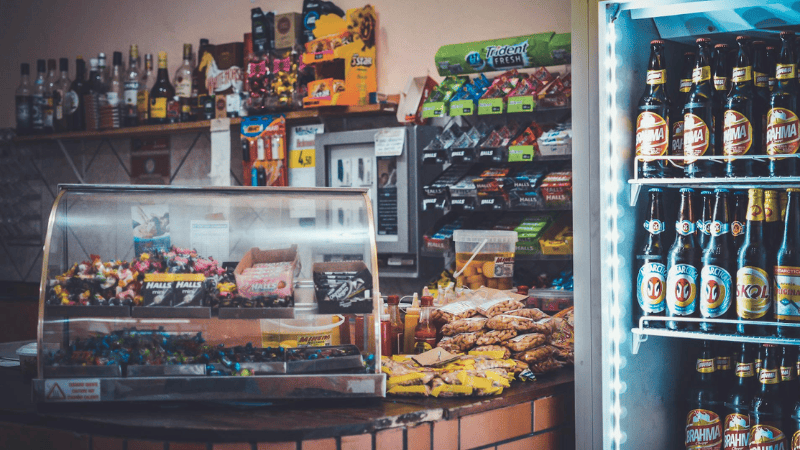
- A retail entrance
- At the very end of a row
- Somewhere right in the mid-store area
- Somewhere on a shelf, among other things
Point-of-purchase displays provide a larger advertising space for brands and retailers to showcase their products. They serve very important purposes when it comes to informing consumers, such as:
- Drawing attention to unique selling points (USPs)
- Building brand loyalty
- Making more sales
Customers at point-of-sale displays have typically done most of their research and are prepared to buy. With those exceptions, point-of-sale displays and point-of-purchase displays are synonymous.
From the registers, the front, the counter, the shelves, the walls, and even the aisles, display boxes may be found just about everywhere in a retail establishment.
Attractive promotional point-of-purchase advertising draws customers’ attention to these display boxes. Depending on the situation, a name-brand vendor may be brought in to make the presentation or a stocker may be assigned to arrange the display according to a planogram.
Ready to Get Custom Packaging for Your Business?
start with a low minimum order quantity
Goals of Point-of-Purchase Displays
In retail settings, POP displays serve three primary purposes.
- Details About the Product: Consumers can always learn something new from a point-of-purchase display, whether they know the product or not.
- Inform Consumers About the Brand: POPs give consumers brand-specific information in addition to products.
- Convince Customers to Buy: These displays grab consumers’ attention immediately. With bright and coordinated colors and intelligent product placement, selling products becomes more effortless.
Additionally, if the point-of-purchase display contains the perfect quantity of product, it could make potential purchasers feel like they must act quickly before it’s gone.
Types of POP Displays
Point-of-purchase advertising can use one of three display types:
1. Temporary PoP Displays
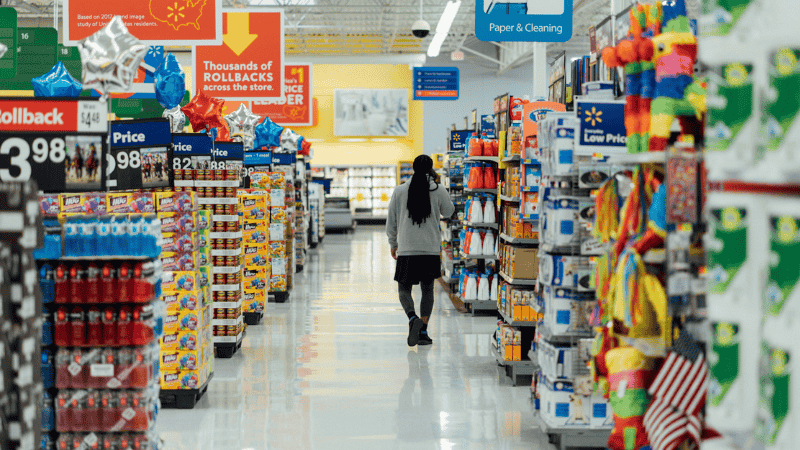
Usually crafted from inexpensive materials like coroplast or cardboard, their useful life is limited to a few months (one to two months max). They’re the best low-cost option for advertising seasonal items or short-term deals.
You can use them to promote sales or product promotions throughout specific seasons. They are shown either as freestanding units, endcap displays, or trash cans. For example, you can find temporary displays showcasing 50–70% off on-season sales in the center of the store.
2. Semipermanent
Also popular as off-shelf displays or secondary displays, these are ideal for displaying new product lines or popular items. They are sturdy and designed to last three to twelve months.
Semipermanent displays are made of durable materials like glass, metal, wood, thicker cardboard, and strong polymers.
From huge aisle displays to more compact countertop displays, there is a wide size range for semi-permanent displays. A pop-up shop showcasing a limited selection of your products or a particular brand could also be a good example.
3. Permanent
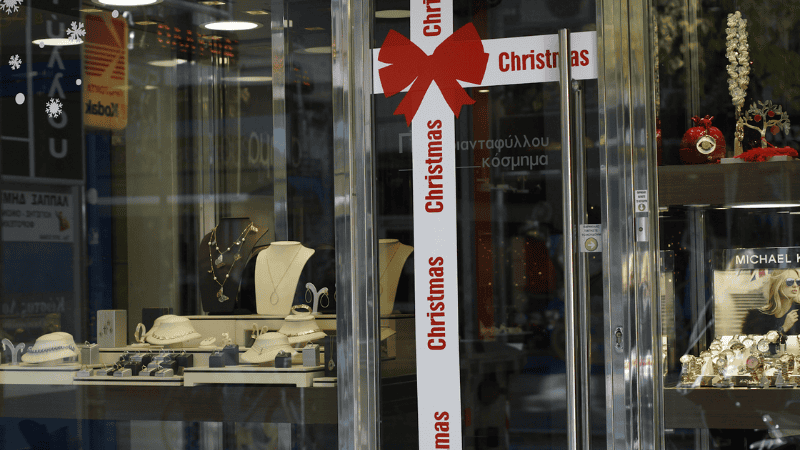
These POP displays are less prevalent than temporary and semipermanent ones, but they can endure for years (3 to 5 years). These displays are made from long-lasting wood, metal, or plastic materials. They work well for displaying year-round flagship or high-demand products.
Permanent displays can serve as the basis for your store’s design, and you can add variety on a weekly, monthly, or as you see fit with temporary and semi-permanent point-of-purchase displays.
For example, you may see that shelves and tables in a jewelry retail store would stay there year after year, while smaller POP displays, such as glass display boxes, would be moved around.
9 Benefits of POP Displays
When it comes to retail marketing, POP displays provide several advantages for businesses:
1. Extremely Targeted
Depending on the shop’s goals, these displays might attract customers. That way, the message, and the products can be more specifically catered to the tastes and requirements of those customers.
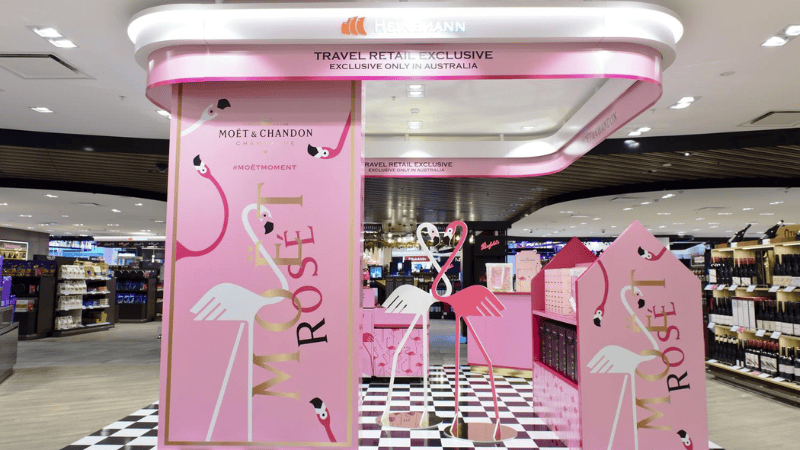
2. Elevates the art of Retail Pitch
Brands can enhance their product advertising in the retail store through the usage of point-of-purchase advertising. To help retailers save time, energy, and space, brands can provide point-of-purchase displays and guide them on placing the display boxes in the store for optimal visibility.
3. Brings Attention to Promotions
Promotional events, time-sensitive sales, and new product launches are perfect showcases for POP displays. They boost sales by drawing attention to the advertising campaigns in the best possible ways.
4. A Reasonable Option
Point-of-purchase displays can be pretty inexpensive for temporary displays. They are simply made from cardboard materials. They offer cheap advertising options for items and raise brand awareness.
5. Simple to Put to the Test
Businesses can rapidly test display designs, messaging, and product placements in the retail store. Thanks to adaptability, testing, and optimization, point-of-purchase advertising can determine what the target audience finds most appealing.
6. Provides Buyer’s Education
For new or complicated products, point-of-purchase displays can be beneficial. They help educate consumers about the product’s worth by providing crucial information and benefits.
7. Enhances Product Exposure
Things that might otherwise go overlooked are given a much better chance of being bought by putting them on striking and attractive POP displays.
8. Attract Buyers’ Interest
Point-of-purchase displays capitalize on imaginative designs and eye-catching images to entice clients to investigate and interact with the products showcased.
9. Boost Revenue
Customers are more inclined to buy things on the spur of the moment when they see them displayed prominently, which is why well-executed point-of-purchase displays can boost sales.
Ready to Get Custom Packaging for Your Business?
start with a low minimum order quantity
What Is the Difference Between POP and POS?
While point-of-sale (POS) and point-of-purchase (POP) displays work to increase brand awareness in a retail setting, they are essential in different ways and serve slightly different goals.
Here is a quick rundown of the two options for your convenience:
| Comparison | POP | POS |
|---|---|---|
| Definition | Perfect for showcasing certain products or highlighting promotions, point-of-purchase displays (POPs) have multiple uses. Creative product packaging, in-store displays, or banners are all examples of what can be considered displays. They can catch consumers' attention and change their buying actions or decisions. | As the name indicates, point-of-sale displays refer to the area right next to the cash register where the actual selling of products occurs. |
| Targeted Audience | Various customer segments are scattered across the store | Customers who make sudden, quick buying decisions |
| Location | Anywhere, all across the store | Near the checkout/cashier’s area |
| Suitable For | Versatile products | Individually packed products |
| Purpose | Point-of-purchase displays educate consumers and encourage them to buy. One can fit a brand's purpose, product advantages, or corporate story. | The purpose of point-of-sale displays is to encourage impulsive buying. They play on the customer's emotions or wants for a pleasurable experience. |
| Example | Banners, product packages, and in-store displays | Magazines racks, candies on display on the aisles leading up to the register, and consumable products in the refrigerators at the end of the checkout line |
Examples of Point of Purchase Displays
Many brands have made good use of point-of-purchase displays for some time now. But some of them never cease to amaze us with their creativity; they draw in clients seemingly out of thin air!
The best POP displays are worth seeing, so let’s take a look at some unique examples that will give you creative ideas:
1. Vendor Shops
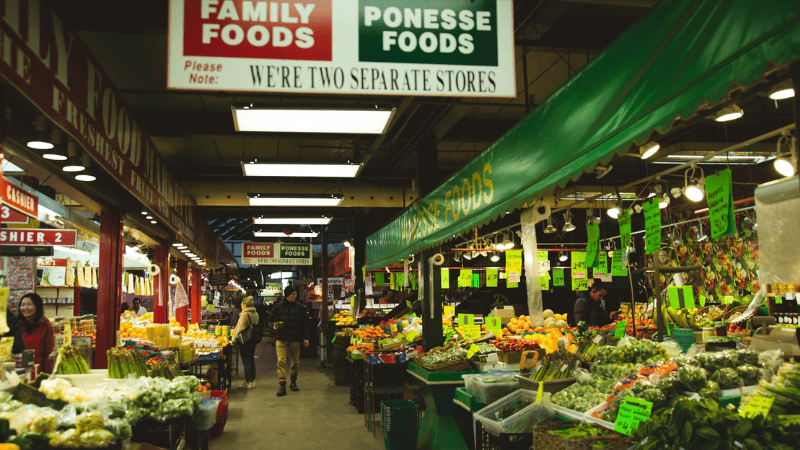
Many people think that vendor shops are an extreme form of point-of-purchase advertising because they are technically stores within stores.
Each brand or product line has space in vendor shops (pop-up stores). Because they necessitate more costly materials and designs, they are typically reserved for long-term or semi-permanent display boxes.
One such vendor is Target, which offers a variety of household goods and appliances.
2. Freestanding Displays
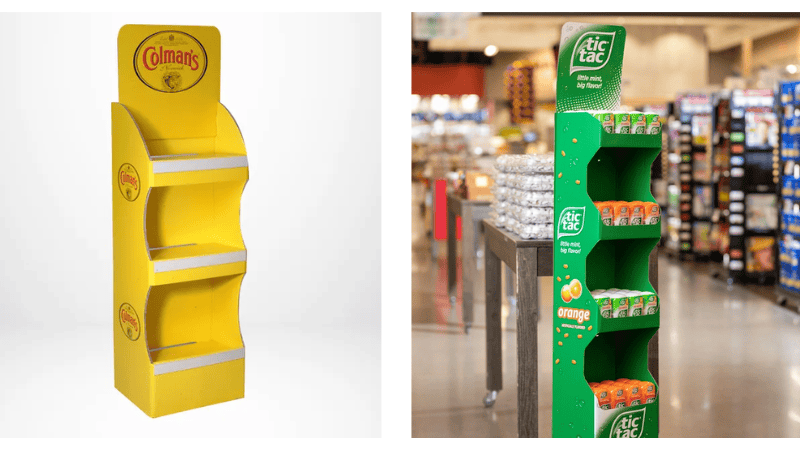
Dump bins and freestanding displays are comparable in that both are independent displays that may be viewed and interacted with from any angle. However, they are better organized than trash cans and can hold more significant items and show them off nicely on hooks or shelves.
Because of their portability and ease of disassembly, freestanding displays are ideal for short-term POP activities. Their adaptability and loads of possibilities for various product placements make them perfect!
Most stores put these displays in heavily populated places because that’s where their consumers will likely be. These display solutions are versatile and easy to customize due to their inexpensive assembly costs.
3. Shelf Talkers
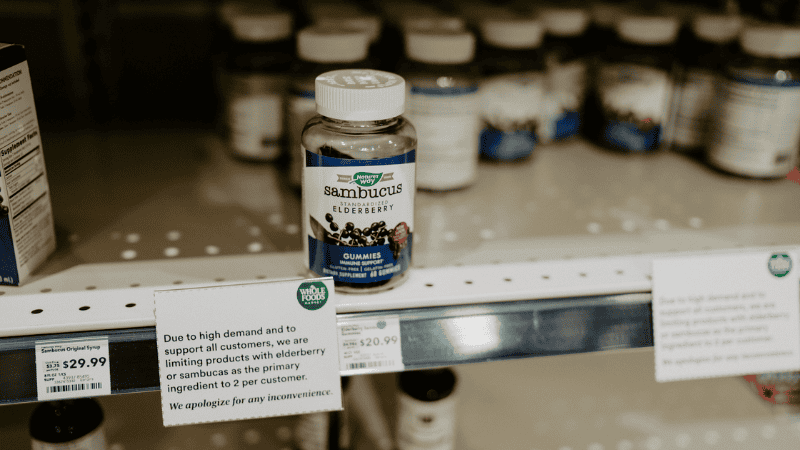
Adhering to a shelf in an aisle is a tiny and colorful rectangular placard called a shelf talker. You will see brand slogans, product names, and features on these.
From tiny arrows to enormous banners stretching an aisle’s length, shelf talkers come in all shapes and sizes. The screens can feature any information that catches your eye. It can be special ingredients, current sales, or brand logos.
If you’re fortunate, you might find a coupon pad with rippable coupons you can use on your purchase. Appropriate purchase decisions are more likely to be made when name-brand products are sold at a discount compared to their retail price.
4. Dump Bins
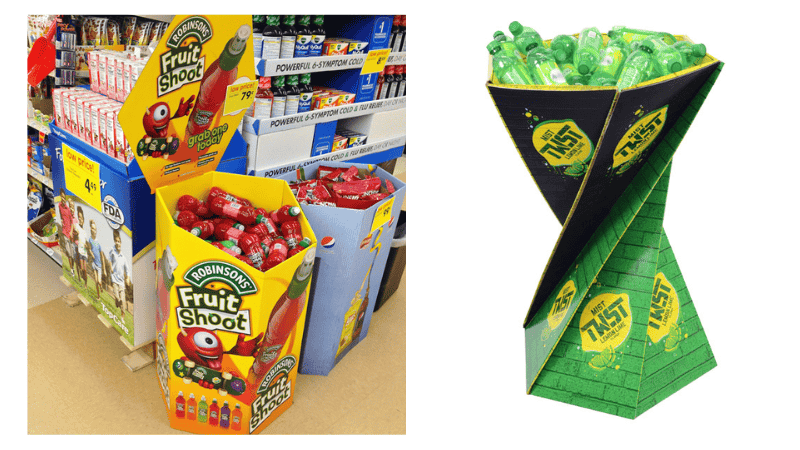
Dump bins are big, square, or rectangular containers holding a single product type or various products of several kinds. This display is ideal for compact items holding more stock at once.
As independent displays, dump bins can be positioned in any way that allows customers to see or interact with them from any angle. In addition to being an accessible item for your distributor or field crew to ship and set up, bins are typically constructed of cardboard or can be customized in some other way. So, you have plenty of room to get creative with how your brand is perceived.
One example is a dump bin full of clearance snacks, toys, cooking utensils, hair accessories, and more. It’s not uncommon to see them stocked with sweets and other tiny items that are sure to attract impulsive purchases.
5. Floor Graphics
Interactive floor graphics can attract customers of all ages, not just those looking to buy. Marketers typically design them with the younger family members in mind since they are closer to the floor and more likely to be captivated.
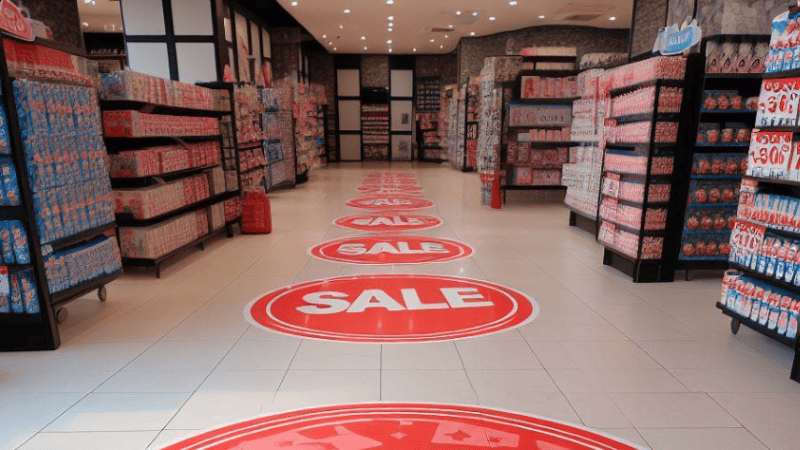
Customers will locate them more quickly once they spend a few seconds wondering what the heck is on the floor and are genuinely attracted by this unconventional approach of advertising anything. That’s why they’re usually positioned just in front of the shelves where your products are stored.
On the floor image, you might see a famous cereal figure guiding kids through a fun game like hopscotch or a maze to reach the product shown.
6. Gondola Display
Stores with more open floor plans often feature gondolas and freestanding shelving units with two sides. Because their shelves are flexible, you can make them fit products of varying sizes.
Although they usually consist of steel frames and pegboards, manufacturers can showcase their products with graphics and a visually appealing color palette.
7. Sidekick Displays
Displays that serve as “sidekicks” are little shelves that innovatively showcase products. They tend to congregate in aisles with a lot of foot traffic or near the registers, where people often make impulsive purchases. Companion displays may have candy bars, gum, breath mints, and more.
8. End Caps

Product displays, known as end caps are typically located at the very end of an aisle at a supermarket, facing the main walkway. Using an end cap is the most effective way to highlight a sale item in this week’s circular.
Research shows that 68% of the time, supermarket retailers use end caps to sort sugary drinks. One possible explanation is that end cap displays are the largest compared to other in-store POP displays.
Well, a more extensive presentation will be more eye-catching than a smaller one!
Ready to Get Custom Packaging for Your Business?
start with a low minimum order quantity
Tips for Creating an Effective POP Display
You must plan and execute your ideas smartly to make your POP displays attractive and effective. The layout of your retail display is just as important as its placement and positioning.
To raise product awareness and, perhaps, sales, here are some pointers for making point-of-purchase displays:
1. Highlight Key Products
The product that the marketer has chosen to showcase will take center stage. In most cases, it is a popular brand that people are already familiar with and adore. Any time a popular product is transformed into a marketing presentation, it will succeed.
2. Utilize Space Wisely
An important factor in the success of each point-of-purchase display is its placement. Put your displays in strategic high-traffic areas of your store, such as the entrances or near the checkout counters. You can also place them at the end of the rows.

Consider how customers will move around your store and position your displays accordingly. Another strategy to promote cross-selling is to place displays near similar or complimentary products.
3. Create an Attractive Layout
Stand out with a well-designed POP display. Use eye-catching visuals that complement your brand’s identity, and use vivid colors and influential typefaces.
4. Emphasize Unique Qualities
Products and brands can highlight their distinctive features with an eye-catching point-of-purchase display. The most popular brand colors, the product’s USPs, and everything else that can sway customers to purchase should all be part of it.
5. Maintain Order and Tidiness
To make purchasing a pleasant experience, keep the display area clean and orderly. Customers may hesitate to peruse further if they see disorganized or cluttered displays. Restock items as needed, ensure all pricing and information are visible, and maintain a clean workspace.
6. Pick the Number of Shelves
Point-of-purchase advertising may require one or more shelves, depending on the product’s dimensions. The sort of retail point-of-purchase display determines the quantity of shelving.
7. Opt for High-Quality Materials
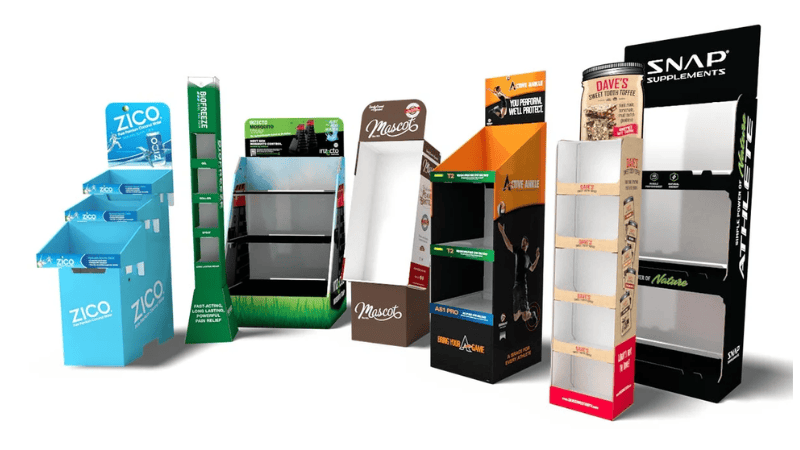
Put your POP displays together with long-lasting, top-notch materials. This is crucial for long-term or semi-permanent displays to ensure they can last the test of time. Also, it is suggested that you use eco-friendly material to make your display more appealing to eco-conscious customers.
8. Always Be Consistent
Remember that your point-of-purchase display should complement your brand’s image and overall advertising strategy. The importance of maintaining brand recognition cannot be ignored at any cost!
9. Benefit from Cross-Selling
Retailers employ cross-selling strategies to encourage customers to buy complementary products to their existing purchases. A helpful method to take advantage of cross-selling is point-of-purchase displays.
10. Offer Demos or Samples
Product utility demonstrations can influence consumer purchasing decisions and increase revenue. Stop limiting your POP talents to the checkout aisle and start using them everywhere.
Putting up point-of-purchase displays in the middle of the aisles is one strategy, but hiring a salesperson to hand out free samples and demonstrate how the products work is another.
Ready to Get Custom Packaging for Your Business?
start with a low minimum order quantity
How to Design Your Retail Display Boxes
The prices for POP displays differ greatly depending on factors like design complexity, material choice, and size. You want to make a POS display that may dissuade customers from leaving your store, but how you do it depends heavily on factors like your retail space’s layout, budget, unique requirements, and who you choose to do it!
This is where experts like Packoi come up with amazingly designed display boxes!
Whether you choose Packoi or design the display yourself, below are some expert points to keep in mind:
1. Add Bold Visuals
The main goal of creating point-of-purchase displays is to attract customers’ attention through striking visuals and content. You can add vibrant colors, big fonts, funny and memorable terms, aesthetic images, and unique shapes.
2. Add Engaging Elements
To engage clients and provide them with more information, use interactive features such as QR codes, touchscreens, or product demos.
3. Add Promotional and Seasonal Themes
To take advantage of certain purchasing tendencies and generate a feeling of urgency, it is a good idea to coordinate your point-of-sale signs with seasonal or promotional themes. You might consider using seasonal decorations, time-sensitive promotions, or themed packaging to spark interest and enthusiasm.
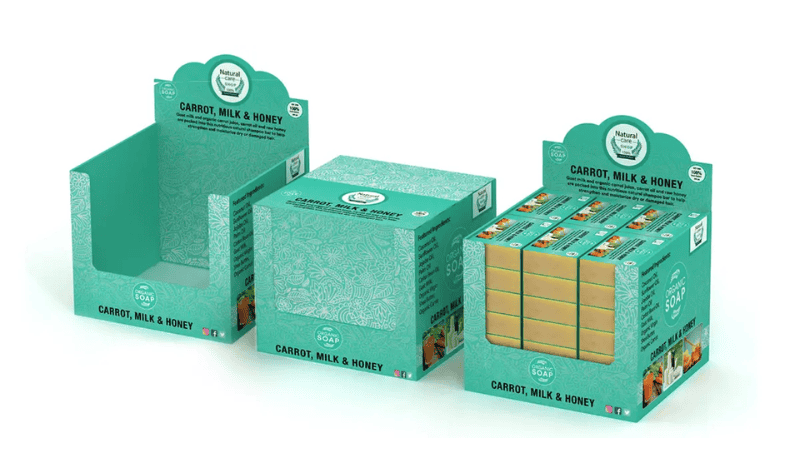
4. Storytelling
Use your point-of-purchase display to convey a story exclusive to your product or brand to make it more engaging. The display can highlight the company’s anniversary story, its secret recipe, or the unique health benefits of the product.
5. Collaborate with Devoted Experts
Think of teaming with POS display experts like Packoi for custom design and manufacture. These experts are well-versed in developing displays that complement your company’s values and goals.
Conclusion
We believe it is evident to you that point-of-purchase displays can do everything to attract customer attention and alter their buying decisions. They are so much more than a promotional tool!
Point-of-purchase advertising can be the live savior for your retail marketers. They can make boring shopping exciting and promote impulsive buying, improving brand loyalty.
No matter the size of your business, becoming an expert at point-of-purchase displays can have a major effect on the competitive retail market.
Meet the Top POP Display Printing Experts
At Packoi, we have the expertise to create visually stunning and top-notch point-of-purchase and point-of-sale displays. Our skilled designers can offer expert design services if you need a unique point-of-sale display. In addition, they can also develop an idea based on your creative brief!
We can design and create point-of-sale and point-of-purchase displays that will turn heads in any retail setting.
Contact us today if you’re all set to raise your in-store visibility and business revenue!



